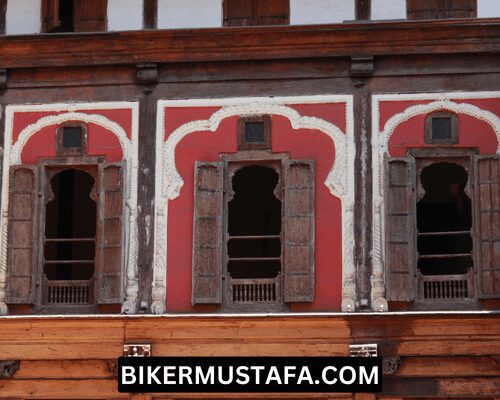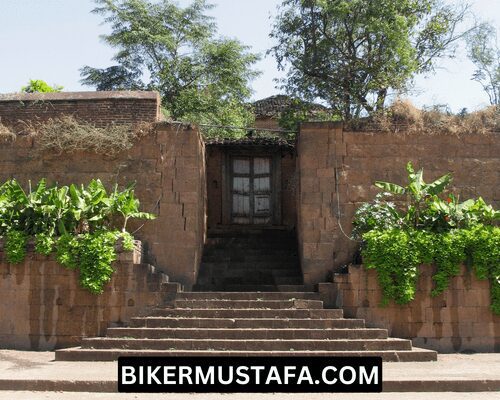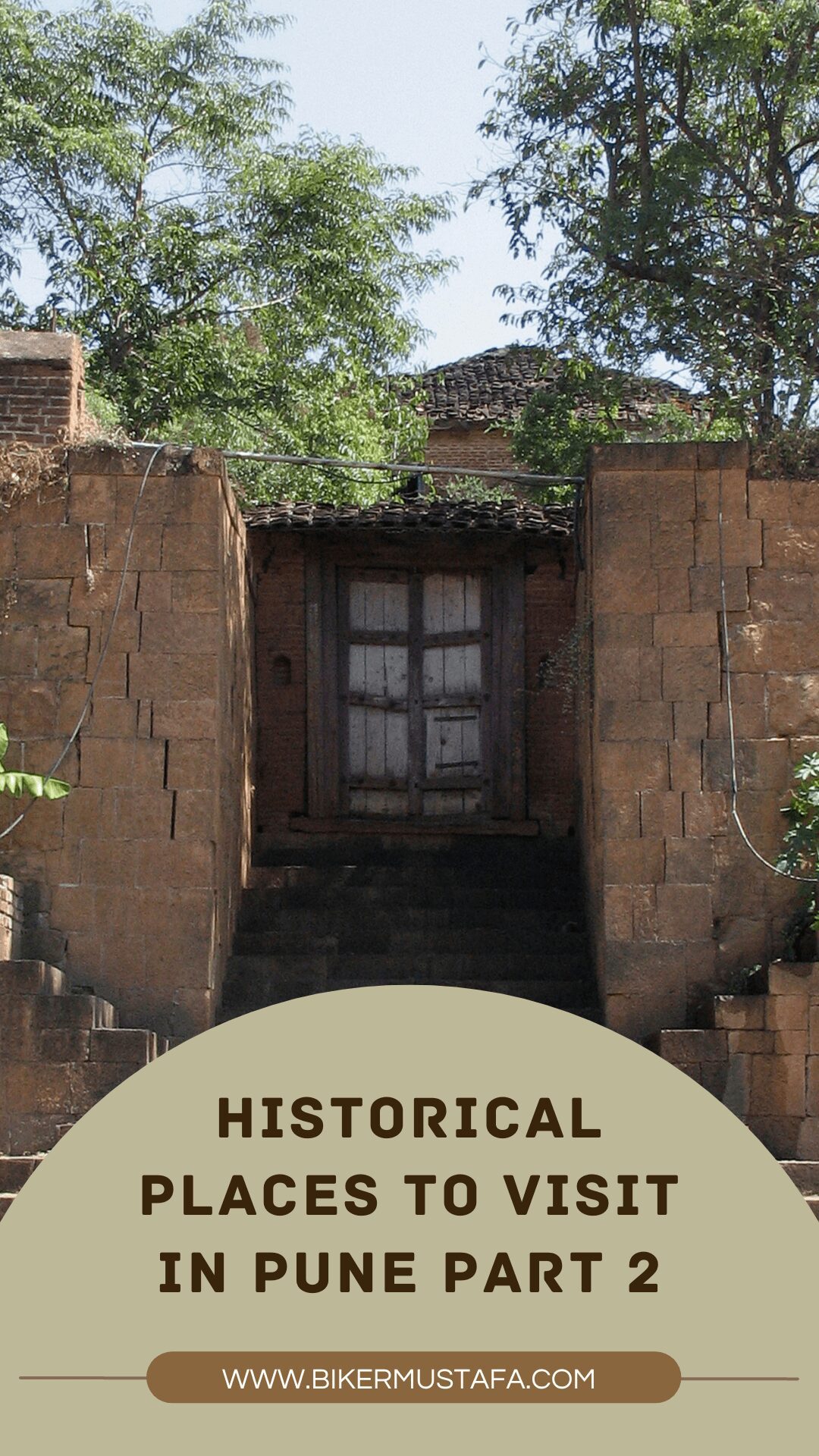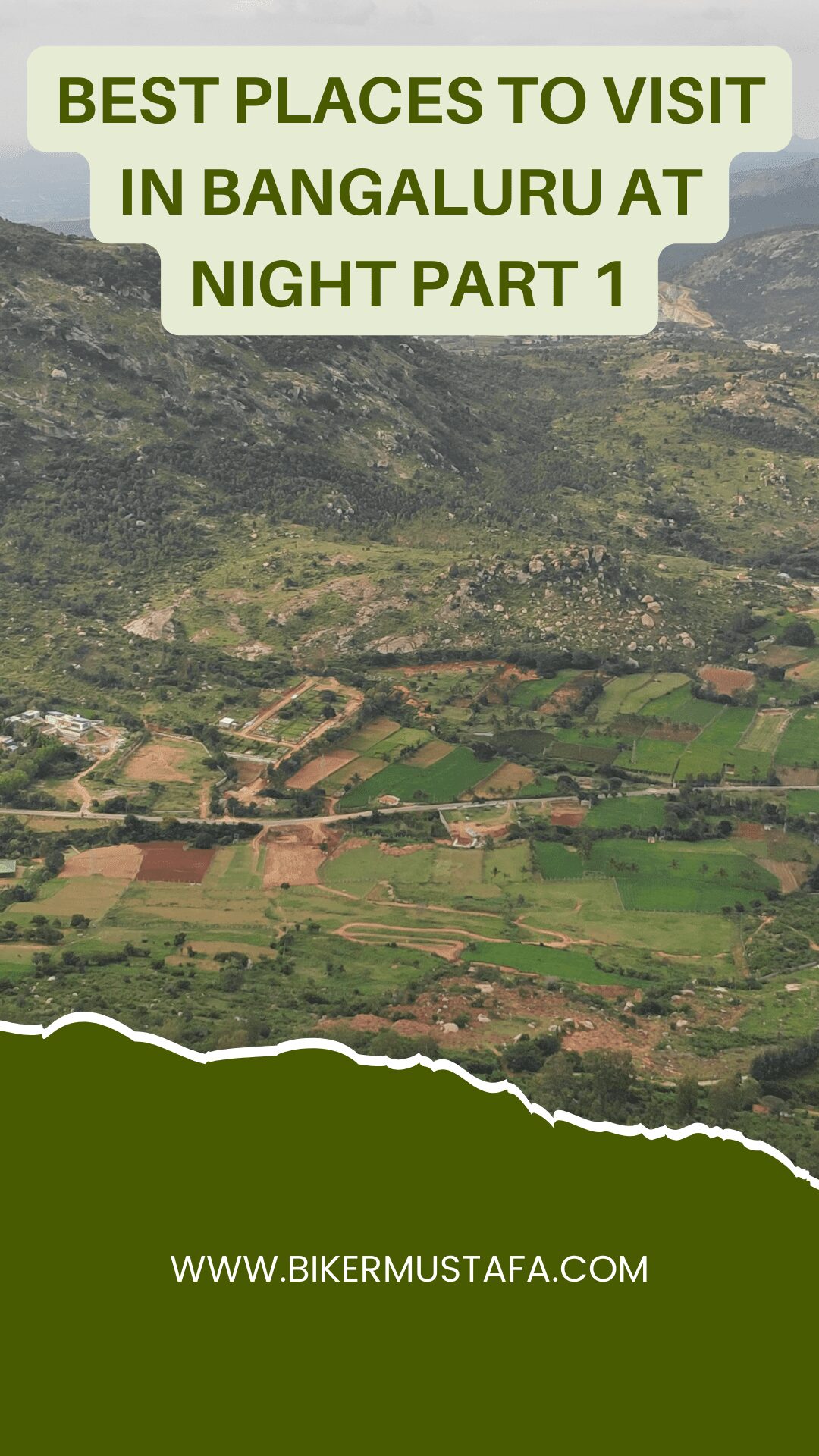Historical Places To Visit In Pune Part 2
Historical Places in Pune with Names
Palace of Shaniwar Wada
In the Indian city of Pune, there is a medieval fortification called Shaniwar Wada. Built-in 1732, it served as the principal residence of the Maratha Empire’s Peshwas until 1818. The palace became the focal point of Indian politics in the 18th century following the establishment of the Maratha Empire.
The fort was primarily destroyed in 1828 by a mysterious fire, but the remaining buildings are still used today as tourist attractions.
History
The seven-story Shaniwar Wada served as the Peshwas of the Maratha Empire’s traditional capital. It was intended to be made of stone. Still, once the first story or base floor was finished, the citizens of Satara, the nation’s capital, complained to Chatrapati Shahu Maharaj (the King), claiming that only he and not the Peshwas could approve and build a stone monument. Following this, a formal letter was sent to the Peshwas declaring that the final structure had to be constructed out of brick instead of stone. If you go today and look closely at the walls, you’ll see that they are still partially built of stone and partially of bricks. The Wada was then finished, and 90 years later, when it was attacked by British artillery, all top six levels crumbled, leaving only the stone base impervious to the cannon’s fire. Therefore, the only Shaniwar Wada element still visible today in Pune’s historic districts is its stone base.

At least a thousand people were residing at the fort by 1758.
Narayanrao, the fifth and current Peshwa, was assassinated in 1773 by guards acting on the orders of his uncle Raghunathrao and aunt Anandibai. According to a well-known urban legend, Narayanrao’s spirit still cries out for assistance on full moon evenings. After his death, Narayanrao Peshwa is said to have cried out, “Uncle, save me,” to several individuals working in the region.
The Peshwa, Bajirao II, ceded his Gaadi (throne) to Sir John Malcolm of the British East India Company in June 1818 and fled into exile in Bithoor, a town close to Kanpur in what is now the Indian state of Uttar Pradesh.
A significant fire broke out inside the royal complex on February 27, 1828. The fire burned furiously for seven days. Only the massive granite ramparts, sturdy teak gateways, and the fort’s deep foundations and ruins were left standing.
He visited Shaniwarwada in 1799 at Bajirao II’s urging, according to Haricharitramrutsagar, a biography of Bhagwan Swaminarayan.
Construction
On Saturday, January 10, 1730, Peshwa Baji Rao I, Chattrapati Shahu’s prime minister, formally placed the foundation stone for his house. The Marathi terms Shaniwar (Saturday) and Wada were used to give it the name Shaniwar Wada (a general term for any residence complex). Teak was hauled in from the Junnar jungles, the stone came from the adjacent Chinchwad quarry, and lime (a mineral) was brought in from the Jejuri lime belts. Shaniwarwada was finished in 1732 for a total of Rs. 16,110, which was a significant amount at the time.
A second Saturday chosen because it was a very encouraging day was January 22, 1732, when the inauguration ceremony was held following religious practices.
The fortress walls, bastions and gates, court halls and other structures, fountains, and reservoirs were all afterward added by the Peshwas. The existing perimeter defensive wall, which surrounds a garden complex with the ancient buildings’ foundations, contains nine bastion towers and five portals. It is located in Kasba Peth, close to the Mula-Mutha River.
| TIMING | 8:00 AM TO 6:00 PM |
| LOCATION | SHANIWAR WADA,PUNE |
| ENTRY FEE | ₹5 PER INDIAN &₹125 FOR FOREIGNER |
Temple of Chaturshringi
The Chaturshringi Mandir, one of Pune’s most revered temples, should be on your list of sites to see when you’re in the city. This temple, located on Senapati Bapat Road near Pune University in Gokhale Nagar, has long been a destination for Mahakali and Shri Chaturshringi worshippers. “Chaturshringi” is derived from the term “Chattu,” which means “four-peaked mountain” and denotes faith and power. There are also idols of Goddess Durga, Ashtavinayaka, and Ganesha in the main temple.
The temple is situated on a slope and is approximately 90 feet high and 125 feet wide. It has been well-maintained for many years by the Chaturshringi Mandir Trust. A ropeway to the Mandir was proposed in 2013 to make the 100-step journey to the Mandir easier for the elderly and physically impaired. This idea was turned down several times by the Charity Commissioner’s office. The Mandir Trust has finally agreed to build escalators up to the temple. Chaturshringi Mandir is not only one of India’s largest and most well-known Mandirs, but it is also one of the most sacred locations, with hundreds of worshippers flocking to it.
More Information on the Temple

The Chaturshringi temple is around 250-300 years old and has been rebuilt numerous times since its construction to ensure that each section of the temple appears brand new. Thousands of devotees still come here to worship and pray to the Lord. One of the most intriguing aspects of this temple is the presence of a smaller counterpart of the Mandir right at the temple’s entrance. As a result, worshippers can readily pray and make offerings at the mini-temple if they so desire.
The Mandir Trust has devised a new development strategy to make it simpler for visitors to perform Sadhana (regulated learning practice), Darshan (the opportunity to see the Deity), Kath-keertan (devotional songs and stories), and Devadarshan (familiar with gods).
Goddess Chaturshringi and Lord Ganesha are the deity patrons of Pune. The temple is frequently seen as a location of maximum positivity and spirituality. As a result, people from all over the world come here every year to worship and make the pilgrimage. This has resulted in a large number of gifts from devotees, which go towards the upkeep of the Mandir.
History
The Chaturshringi Temple’s history may be traced back to the Maratha era through the narrative of Durlabsheth Pitamberdas Mahajan. He was a follower of the goddess Chaturshringi. He was a wealthy Peshwa trader who was deeply devout. He is supposed to have travelled from Pune to Vani on the full moon day of Chaitra solely to worship Saptashringi Mata. However, he ceased making his yearly visit a few years later. As a result, the overseeing Deity appeared in his dreams and begged him to carry her the statue from Pune’s Northwestern Mountain so that she might stay close to his devotee. Durlabsheth proceeded to the aforementioned mountain to fulfil the goddess’s wish, and to his amazement, he discovered his goddess’s idol.
Out of utter joy and contentment, he decided to build a shrine on the location to commemorate this experience. This resulted in the establishment of one of Maharashtra’s oldest temples. Even now, the narrative of Durlabsheth remains an important element of the stories that are told all throughout the world.
Festivals Although the temple is open to the public at all times, and it is most packed during the “Navratri” celebration. This is a nine-day festival honouring Goddess Durga.
On the day of Navratri each year, a fair is conducted on the temple’s slopes. The entire Chaturshringi Mandir is illuminated with traditional Indian lamps. Devotees flock here to witness the silver Murti (idol) yatra, in which the statue is conveyed in a silver chariot. This ceremony occurs on the last day of the festival, commonly known as Dussehra.
Every year, the temple hosts a major festival during Navratri. It was alleged last year that the flowers were dumped by flying helicopters. The helicopters are also expected this year. In addition, images of the god will be shown on LED televisions at the temple’s entrance so that eager devotees can begin their Darshan right away. Furthermore, speakers and FM channels will be put around the temple grounds, with public announcements and devotional songs being played on demand. In addition, the Mandir Trust intends to make the temple a Wi-Fi hotspot. However, 18 CCTV cameras, fire brigades, and ambulances with a constantly accessible doctor squad will be regulated at the temple to ensure a safe occasion on the auspicious days.
Architecture
The temple is built on a slope that is 90 feet high and 125 feet broad. Because the name means “four peak mountains,” the temple was built across four ranges. Eight small idols of Lord Ashtavinayaka are scattered across four mountain summits in the Ganesh shrine. The 100-steps to the temple are well-built, with seating and resting areas every six steps. The steep journey is made simpler by frequent rest stops along the way, and drinking water is accessible throughout the temple complex. The Mandir Trust developed and maintains waterfalls, Dharamshala for individuals who want to stay overnight, nagarkhanas, fountains, and water banks. This has made travel more convenient and tranquil for devotees who make the time and effort to visit this prominent sacred site.
Notices and Timings
The Chaturshringi temple is open from 6:00 a.m. to 9:00 p.m. every day. However, times may vary during festivals and/or holidays.
On Tuesdays and Fridays, the temple shuts at 12:30 p.m. This is due to the fact that these two days are dedicated to the goddesses, with the greatest number of devotees visiting the temple to adore them.
There is no admission price, and the temple is open to the public. It should be noted that photography and videography are absolutely forbidden inside the shrine.
How to Get to the Chaturshringi Temple
Cabs, cars, buses, and automobile rentals are available from any location in Pune for residents. The nearest airport for tourists is the Pune international airport, which is about 14 kilometres away. The nearest railway station is around 4 kilometres away, at Shivajinagar Railway Station. The temple is approximately 7 kilometres from Pune Junction. Car rentals, cabs, autos, and buses are available from these locations all the way to the temple.
Tourists can also hunt for the internet “yatra buses” from their cities to Chaturshringi Temple, particularly during the festive season.
| TIMING | 6:00 AM TO 9:00 PM |
| LOCATION | SHIVAJI NAGAR,PUNE |
| ENTRY FEE | FREE |
Temple of Pataleshwar Cave
There are caverns you are afraid to enter, but not all of them are! Some of them resemble fantasies and bear the light within. Pataleshwar Cave Temple in Pune houses a treasure that few of us are fortunate enough to discover. Right in the centre of town! Yes, this protected cultural site in Pune is a stunning monolithic creation carved out of a single rock.
Pataleshwar Temple is visited by a large number of worshippers and visitors and holds religious significance for Hindus. The centuries-old temple is a visual feast with all of its carvings and miniatures adorning its walls. Spend some tranquil moments here or sit in a corner and connect with the almighty; this temple is an amazing find that will captivate you on your next trip to Pune.
HISTORY
Pataleshwar Caves in Pune are devoted to Lord Pataleshwar, a Shiva-related name. The word ‘Patal’ means ‘underworld,’ and the word ‘Ishwar’ means ‘Lord.’ There is a temple dedicated to Lord Shiva and Nandi inside the caves, which was built from an excavated monolithic rock during the rule of the ‘Rashtrakuta Dynasty’ in the 8th century AD. The protected site is notable for its passageways, round Nandi Mandapa, and enormous pillars.
Pataleshwar Temple is also known as Panchaleshwar Temple or Bhamburde Temple. According to mythology, the Pandavas erected the temple in just a few hours while they were in exile and needed a place to stay. The seating arrangements for tourists inside the modest temple rooms have been meticulously constructed so that you can sit and marvel at the temple’s genuine majesty.
What distinguishes Pataleshwar Cave Temple?
With its well-constructed pillars, massive spherical stones, and rotunda roof, the temple appears to be a magnificent work of art. Another great example of craftsmanship is Nandi Mandapa, which rests beneath the roof. The sound of the bells is very distinctive.
If you look closely, you will notice parallels in the architecture of Pataleshwar temple and Elephanta Caves.
Aside from the magnificent engravings on the black temple rocks, there is something quite small that draws a lot of attention: a grain of rice. The grain, which is stored in the caves’ museum, has 5000 letters inscribed on it and is listed in the Guinness Book of Records. Inside the temple complex, you can also locate the idols of other Hindu gods, such as Ram, Lakshman, Sita, Ganesh, and Lakshmi.
| TIMING | 8:30 AM TO 5:30 PM |
| LOCATION | SHIVAJI NAGAR,PUNE |
| ENTRY FEE | FREE |
Museum Raja Dinkar Kelkar
In Pune, Maharashtra, India, there is a museum honouring Raja Dinkar Kelkar. It includes Dr Dinkar G. Kelkar’s (1896–1990) collection, which is devoted to Raja, his only son. Several sculptures dating back to the fourteenth century are housed in the three-story structure. Additionally, there are ornaments made of ivory, silver, and gold, as well as a beautiful array of musical instruments, combat tools, and containers.
History
Around 1920 saw the beginning of the collection, and by 1960, it had about 15,000 items. Dr Kelkar donated his collection to the Maharashtra government in 1975 after the museum was founded in 1962.
2,500 of the museum’s more than 20,000 artefacts are kept on exhibit. These primarily include artefacts from the 18th and 19th centuries as well as Indian decorative items used in daily life. The museum’s collection showcases the talents of the era’s Indian artists, including well-known pieces by Pandit Abhijeet Joshi.

The museum provided a virtual tour during the COVID-19 outbreak in India.
- Collection.
- Framing of a door.
- Vessels.
- Ornaments.
- musical apparatuses
- Various sculptures and paintings serve as remarkable examples of their work.
| TIMING | 8:30 AM TO 5:30 PM |
| LOCATION | SHUKRAWAR PETH,PUNE |
| ENTRY FEE | ₹5 FOR CHILDREN, ₹20 FOR ADULTS ₹200 FOR FOREIGNER ₹50 FOR FOREIGNER CHILDREN |
Fort Lohagarh
In India’s Rajasthan state, Lohagarh Fort (also known as Iron Fort) is located in Bharatpur. The Jat lords of Bharatpur built it. The Lohagarh Fort, one of the most powerful structures ever constructed in Indian history, was one of the many forts and palaces that Maharaja Suraj Mal (1755–1763 CE) built throughout his empire. During the siege of Bharatpur in 1805, when British soldiers under Lord Lake laid siege for more than six weeks but failed in all four attempts to storm the bastion, the impenetrable Lohagarh fort could survive repeated assaults. The Ashtdhaatu (eight metalled) gate, one of the fort’s two entrances, is known as such because it faces the north; the Chowburja (four-pillared) gate, on the other hand, faces the south. The fort contains the Kishori Mahal, Mahal Khas, and Kothi Khas monuments.

Raja Jawahar Singh constructed Jawahar Burj in 1765 to honour his victory against the Mughals at the Battle of Delhi (1764). Additionally, the king’s coronation ceremony took place at the Jawahar Burj. Raja Ranjeet Singh constructed Fateh Burj in 1805 to honour his victory against the British during the Siege of Bharatpur (1805).
The following components of the fort have been given the status of State Protected Monuments in Rajasthan: Kamara Khas, Kishori Mahal, Hansarani Mahal, Kachahari Kala, Chaman Bagichi, Hammam & mudwall gates, including Mathura gate, Binarain gate, Atal Bandh gate, Anah gate, Kumher gate, Govardhan gate, Neemda gate, Chandpol gate, and bastion near Suraj pol.
Jawahar Burj, Ashtadhatu Gateway, the moat around the fort wall, the fort walls including Chowburja gate, and the approach bridges at the Chowburja and Ashtadhatu gates are all classified as Monuments of National Importance in Rajasthan.
| TIMING | 9:00 AM TO 6:00 PM |
| LOCATION | LOHAGAD TREK ROAD,PUNE |
| ENTRY FEE | FREE |
Lal Mahal
Lal Mahal, a historical relic from the 16th century, is located close to Shaniwar Wada in Pune. The palace has interesting tales to tell about being the target of numerous invasions and a brief resurrection. Shahaji Bhosle, the father of Shivaji Maharaj, had it initially renovated in the 1630s so that his family could live there. This red-coloured building, which served as Chhatrapati Shivaji’s childhood home before he confronted Shaistekhan, is an architectural wonder that captures the style and craftsmanship of the era.
The Lal Mahal, which has an illustrious past, emphasises the bravery of the emperors and leaders of that era. The Peshwas were renowned for elucidating the lives and valiant deeds of the Maratha Kings. Due to ongoing damage to the building, there isn’t much to show or discuss at this location. As a result, many details, such as the size and number of rooms, are left up to the imagination. A Peshwa on guard guarding the Taj Mahal and a Maratha soldier riding a horse, however, transport you back in time.
History
Shivaji Bhosle’s father, Shahaji Bhosle, erected the Lal Mahal in an effort to rescue Pune from the devastation and suffering that had befallen it. He served as a Sardar in the Bijapur Sultanate. He was assigned a few areas in Pune while he was still living in Bangalore with his family and had already conquered a number of them. In 1630 AD, he built a mansion for himself to live in. He sent his wife Jijabai and son Shivaji to remain here after creating this marvellous masterpiece. He lived here up until 1645 when he bought his first fort, Torna Fort. The Mahal was destroyed once more by numerous assaults near the end of the 17th century. Shaniwar Wada was being constructed during the time. According to legend, Shaniwar Wada was built using soil, stones, and other building materials taken from the Lal Mahal as a sign of good fortune. In order to build homes, some of the Mahal’s land was donated to Ranoji Shinde and Ramchandraji. Even now, Brahmins are fed. The structure was never reconstructed after numerous assaults. What is visible today is really a scaled-down reproduction of the red building.
Another legend surrounding this location emphasises Shivaji Maharaj’s liaison with Shaistekhan. When Shivaji and his 400 warriors reached the Mughal Camp’s main gate in April 1663 during the holy month of Ramzan, they pretended to be a party of Deccan soldiers who had come to liberate the Mughal soldiers who were on shift. After breaking the fast, Shaistekhan and his family were sound asleep, and the moonlit Lal Mahal (which belonged to Shivaji) was completely dark. In order to enter the palace with his soldiers, Shivaji cut a hole in the kitchen wall. Everyone who was resting on the bed was murdered. There were yells, shouts, and an atmosphere of panic. The Son of Shaistekhan perished in this tragedy. Khan also suffered three finger losses from Shivaji’s sword strike while attempting to flee from the Lal Mahal’s windows. The Marathas later managed to flee the Mahal and make it to Sinhagad, where they were staying.

Architecture
The “Lal Mahal” monument is red in colour and a masterpiece of architecture, as suggested by its name (“Lal” means “red” and “Mahal” means palace”). The walls of this red-coloured brick building include carvings and pictorial representations that provide a view of Shivaji’s life, from his early years through his impressive conquests. An image of Shivaji ploughing the ground with a lovely golden plough and being praised by his mother, Jijabai and his Guru, Dadoji Konddev, can be found somewhere in the Taj Mahal.
Due to the attacks that hit Pune, the majority of the building was destroyed. Just a small portion of it is visible at this time. However, the monument began undergoing renovations in 1984, which were started by the Pune Municipal Corporation and finished in 1988. Additionally, there is a Jijamata garden here that is devoted to his mother and attracts a lot of visitors all the time, particularly elderly people and little children.
Here, you can see a miniature recreation of the Raigad Fort to get a sense of how the forts formerly seemed, what made them, etc. With this, one can also comprehend the design principles that went into creating the structure, including the strategic attack and defence points, troop placement and positioning, outpost locations, rooms for the king, his family, and staff, the military arsenal’s access, hidden escape routes, and everything else related to guerilla tactics.
Importance
In addition to being linked to conflicts and conquests, the Lal Mahal played a significant role in Chhatrapati Shivaji’s life as it was where he spent nearly his entire youth. Having said that, it portrays Peshwa’s upbringing, familial values, and deep origins. The Mahal honours his mother, “Jijamata,” whose statue is on display at the courtyard’s entry. On the terrace top of the Mahal, there are four umbrellas that are indicative of the Peshwa era.
It is also believed that this is where Chhatrapati Shivaji wed his first wife, Maharani Saibai, and where she afterwards made her home. According to the Maratha account, the Lal Mahal was used to host a feast for the Brahmins. This feast came after Sadoba, Chimaji Appa’s son, had his “Janeu” (thread ceremony).
- Before entering the area, take off your shoes and leave them at the door.
- This location is accessible throughout the entire year.
- The first level is accessible through a set of steps, however, as of right now, it isn’t accessible to the general public because the PMC (Pune Municipal Corporation) plans to turn it into a museum.
- If you have the time, you may always visit the garden that surrounds the Taj Mahal and relax in the shade of a tree.
Where to Find
- Pune has excellent rail, air, and road connections. In the Kasbapeth neighbourhood, Lal Mahal is close to the Ganpati Gate of the Shaniwar Wada, another significant Peshwa legacy relic.
- Getting here is not a difficult task. Due to its central location in Pune, it is easily accessible. One can choose a bus, rickshaw, cab, or hire a car from the many possibilities for transportation in the city, depending on their price and convenience.
| TIMING | 9:0 AM TO 1:00 PM 4:00 PM TO 8:00 PM |
| LOCATION | DURVANKUR SOCIETY,KASBA PETH,PUNE |
| ENTRY FEE | ₹3 PER PERSON |
Shivaji Bridge
Shivaji Bridge, one of Pune’s most significant architectural icons, is a must-see while you’re here. Despite being more than 110 years old, this enormous structure, also known as Lloyd Bridge, is still referred to as “Nava Pul” or the new bridge. You may relive the splendor of the mighty Mughal Empire by crossing this bridge across the Mutha River.
The bridge’s stunning black basalt stone arches, carved poles, and floral designs are not missed. Historians say some prehistoric Hindu and Jain artifacts may be buried beneath the bridge.
| TIMING | Accessible at all times. |
| LOCATION | Near Pune Municipal Corporation Building. |
| ENTRY FEE | No entry fee. |
Vishrambaug Wada
Peshwa Baji Rao II, the final Peshwa of the Maratha confederacy, lived in a beautiful home called Vishrambaag Wada in early 19th-century Pune on Thorale Bajirao Road. On the bottom of the 20,000 square foot, Wada is a post office, a few other municipal administration offices, and a tiny museum of Maratha antiquities that renowned Maratha historian Babasaheb Purandare assembled. This building is renowned for its elegant entryway, balcony, and intricate wood carvings.
History
The Vishrambaug Wada was constructed in 1807 AD for Rs 200,000. The building project took six years to complete. Baji Rao II favored this home above the unfortunate Shaniwar Wada, the Peshwas’ stronghold. Before being defeated in the Third Anglo-Maratha War, Baji Rao II lived at this location for eleven years. After the war, the British deported him with a pension to Bithur near Kanpur. Varanasibai, his wife, remained here for a while before moving in with him in Bithur. The British quickly occupied Pune.

To maintain Sanskrit education in the city, the new East India Company overlords of Pune founded the Hindoo college in the Wada in 1821. The college served as the prototype for Poona College, which eventually changed its name to Deccan College. The palace also housed a high school known as Vishrambag High School. The eastern wing of the Wada was destroyed by arson in 1871.
For a fee of Rs 100,000, the colonial Bombay Presidency government sold the property to the then-Poona Municipality in 1930[citation needed]. Vishrambaag Wada served as the headquarters for Municipality and its successor, the Pune Municipal Corporation (PMC), until 1959. Up until 2003, the Wada housed the offices of several PMC departments.
Restoration
Under the Heritage Corridor Plan, the PMC has taken up the Vishrambaag Wada repair project. Three phases of conservation are planned, beginning with the double-story house where the Peshwa is reputed to have kept a battery of 6,000 enslaved people.
The ancient bricks Wada are being specifically restored, according to Shyam Dhavale, director of PMC’s preservation unit. A few of the windows, wooden pillars and decorative elements are also. The courtyard and sloping roof’s red tiles will remain a hallmark of Maratha architecture. As of 2004, the repair effort had cost 2,500,000 (about $31,000).
| TIMING | Every day (except Monday) 10:00 am to 7:00 pm |
| LOCATION | 619, RB Kumthekar Road, Perugate, Sadashiv Peth, Pune. |
| ENTRY FEE | Rs. 5 per adult. |
Rasalgad
India’s Maharashtra state has the Fort of Rasalgad. It’s 15 kilometers east of Khed City. The Fort has been transformed into a tourist destination. Its defenses are in terrific shape. The Fort was located at the southern end of a short spur that connects Suamargad and Mahipatgad to the north. In 2003, the Archaeological Survey of India designated the Fort as a protected monument.
History
About this Fort’s past, little is known. The Morè (tribe) of Javli was holding this fort captive when Shivaji Maharaj took control of it. From the Peshwas, British armies took control of it in 1818.
Sights to view
Weekends see a spike in visits to the Fort. It is situated on a five-acre, small triangular platform walled on all sides. The two gates at the entry are in good shape. Near the first gate is an idol of Veer Maruti. A stone Deepmala, Tulsi Vrindavan, and a Zolayidevi shrine can be seen on the Fort. On the Fort, there are two sizable rock-cut water cisterns. The Fort is armed with 16 guns. A well-kept storage is present. You can view Chakdev and Parvatgad from the Fort. Earlier, it was noted that there were only 16 cannons on the Fort based on the information above. A half-broken 17th cannon was in front of the granary. Then, on January 23, 2022, the Sahyadri Pratishthan removed the 18th cannon from a valley 400 feet east of the Fort and set it up in front of the Fort’s Zolai Devi shrine. The 19th cannon was discovered on March 6, 2022, in a 150-foot valley below the Peer Buruja on the Fort’s western flank. Sahyadri Pratishthan Khed Vibhaga performed this performance. Cannon nos. 18 and 19 The state Archaeological Department received information.
How to contact
- Rasalwadi is a settlement at the base of a hill. It has excellent road accessibility. Rasalwadi is a 10-minute drive from the Fort.
- Trekkers frequently overnight in the Fort’s temple. From Rasalgad, one may travel to the Suamargad-Mahipatgad trek.
| TIMING | Anytime |
| LOCATION | Khed, Maharashtra. |
| ENTRY FEE | No entry fee. |
Tribal Museum
This museum is an excellent opportunity to get to know these elusive people, which is otherwise not feasible. Tribal groups have long been interesting. The location is home to a fantastic collection of artifacts from over 47 Maharashtrian tribes. You will see their jewelry, pictures, guns, hunting, and music-making equipment.
These collections also include many artworks, tools, clothes, and masks utilized in tribal dances. This museum, built in 1962 and now a component of the Tribal Research and Training Institute, significantly contributes to knowledge about these people, their ways of life, and their culture.
| TIMING | Every day (except Sunday)- 10: 00 am to 5:00 pm. |
| LOCATION | 28, Queen’s Garden, Near Old Circuit House, Bund Garden Road, Pune. |
| ENTRY FEE | Rs. 10 per adult. |
Dehu Gatha temple
The most prominent and most respected temple in the city is Dehu Gatha Temple. It was constructed in the 17th century along the Indrayani River banks and is dedicated to Sant Tukaram Maharaj. The sculptures depicting the Saint’s tales are the most critical feature of the shrine. People think everyone visiting this temple must read at least three of these because they are simple to read.
Additionally, there is an idol of Lord Pandurang there. An adequate time to go is in the month of Ashadh (June–July), when people tell stories about the Saint, and colorful processions are held in his honor.
| TIMING | Every day |
| LOCATION | Dehu Village Haveli, Maharashtra. |
| ENTRY FEE | No entry fee. |
Nana Wada
Nana Phadnavis (1742-1800), the top administrative officer of the Peshwas, constructed Nana Wada, a traditional residence measuring 20,000 square feet, which is situated next to the Vasant Theatre in Budhwar Peth. This house is said to have been constructed by him in about 1780 for personal use.
The Wada, a magnificent example of Peshwa architecture, is mainly constructed from sagwan wood (teak). It contains wood columns that imitate cypress trees, wooden railings, and a ceiling. The walls and ceiling also have different carved designs, and some wall paintings are now very faded. A diwan khana (courthouse or audience hall) made of black polished wood is located on the first level of the Wada. Additionally, it includes a stairway in the wall that goes out of the mansion in an emergency.
The New English School in this Wada was first run by the Deccan Education Society, established in 1884 by Gopal Ganesh Agarkar, Mahadev Ballal Namjoshi, Vaman Shivram Apte, V.B. Kelkar, M.S. Gole, and N.K. Dharap. A new stone building replaced many of the previous construction without keeping records. Because it was constructed in the British Gothic (revival) architectural style, this new section of the Wada differs from its rest.

The Pune Municipal Corporation (PMC) acquired the site from the Deccan Education Society in 1953. 2010 saw the start of the mansion’s conservation efforts. Today, Nana Wada is home to the PMC’s records office and a school also administered by the organization. It has Grade I heritage structure certification from the Pune Municipal Corporation. A museum called Swarajya—Journey of Freedom Fighters has also been constructed on the property, and restoration work has already started on certain portions of the Wada. The biographies of Bal Gangadhar Tilak, Lahuji Raghoji Salve, and Umaji Naik Khomane, to name a few, are all included in this museum. The Wada, one of the city’s oldest historical landmarks, preserves Pune’s past in this way.
| TIMING | Every day 8:00 am to 8:00 pm. |
| LOCATION | 715, PMC Vidyalaya Road, Budhwar Peth, Pune. |
| ENTRY FEE | No entry fee. |
Mahatma Phule Museum
In the Indian state of Maharashtra, in the city of Pune, is the Mahatma Phule Museum. It was established in 1890 under the name Poona Industrial Museum before changing its name to Lord Reay Museum. It was renamed the Mahatma Phule Museum in 1968.
Sections
The museum has sections with various images, charts, models, tools, and science-related models. The exhibits cover geology, minerals, handicrafts, cottage industries, agriculture, forestry, natural history, and armory, as well as industry and engineering. The arsenal has Mughal and Maratha-era firearms. Some maps list the several forts in the Pune district. The natural history department has a taxidermy collection of numerous animal species, birds, insects, snakes, and fishes. Models of Indian irrigation, hydroelectric, and oil refining techniques are displayed in the industrial area, which also explains scientific agriculture.
Library
Since the beginning of the museum, a library has been there. It includes works on a range of topics, particularly those on museology and ancient technology.
Gharpure, B. V.
Rajeev Vilekar, the museum’s current administrator, is quoted in a TOI news article as saying: “From 1930 until 1954, Gharpure served as the museum’s curator. He made enormous contributions to the museum, and one of the halls here is named in his honor “. According to a Toledo Blade news article, B.V. Gharpure, curator of the “Lord Reay Maharashtra Industrial Museum, Bombay,” visited Toledo in March 1948. According to Gharpure, quoted in the article, the museum’s goal is to “teach an uneducated populace contemporary ways of agriculture, engineering, and science.” According to the article, Gharpure was traveling abroad for a whole year, stopping in places like Russia and Germany.
Srishtidnyan
The museum produces Srishtidnyan, a science magazine that uses straightforward language to convey scientific advancements to laypeople. It was the first popular Marathi scientific publication, starting in 1928. Popular articles are contributed to the magazine by scientists and subject-matter specialists in several fields of science and technology.
| TIMING | Every day 9:00 am to 5:00 pm. |
| LOCATION | 1204/10, Ghole Road, Shivajinagar, Pune. |
| ENTRY FEE | No entry fee. |
Recommended Articles:





One thought on “Historical Places To Visit In Pune Part 2”